In today's world, you no longer need an office or even physical products to make money, as ecommerce and information products have become an increasingly popular business model. It’s no wonder that the volume of transactions with digital products has increased by almost 70% in the last two years.
So, if you have creativity and an entrepreneurial spirit, selling digital products can be a very profitable business model that doesn’t require manufacturing, shipping, or inventory costs.
You just need to know what to sell, how to market it, and where to find buyers.
Want the quickest answer on where to sell your digital products? Whop is the solution. With Whop, you can sell practically anything and you can get started in just a few minutes.
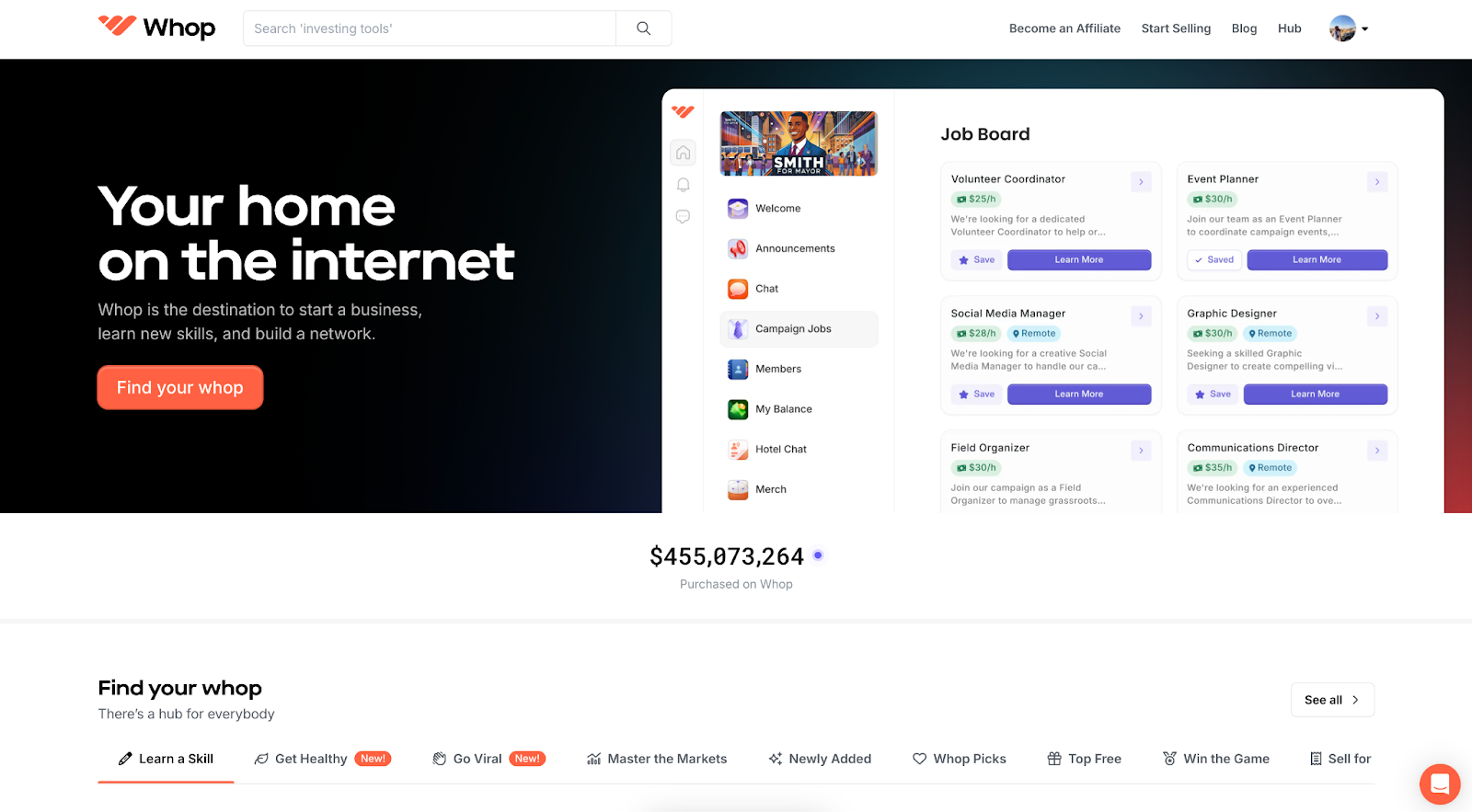
But if you want to learn more about some of the best places to sell digital products in 2024, look no further. Keep reading and find out!
Why Should I Sell Digital Products?
Selling digital products can be a very profitable business model for several reasons. Here’s an in-depth look at why you should sell them.
Low Overhead Costs
Unlike physical products, digital products don’t require manufacturing, shipping, or even inventory management, which drastically reduces your startup costs.
And since there are minimal production and distribution expenses, you can technically sell a digital product indefinitely once it’s first created. Lower costs, higher profit margins.
Global Reach
Because they can be downloaded right after the purchase is completed, digital products can be delivered instantly anywhere in the world, allowing you to reach a global audience without the logistical challenges of international shipping.
Digital products can be purchased and downloaded at any time, and your potential customer base is anyone in the world with an internet connection and the desire to buy your products.
Passive Income Potential
Digital products are an excellent source of passive income because once you’ve created a digital product, it can be sold repeatedly and indefinitely without needing to be recreated.
You don't need to worry about running out of stock and you can continue to earn money on that digital product long after the initial work is done. With multiple products, your customers will have more purchasing options and consequently, your passive income potential is greater. So let your creativity run wild.
How Can I Sell Digital Products?
Of course, selling digital products successfully will require a little more than just creativity and an idea. You need to pay attention to a number of factors and take steps to be successful in this business model.
Identify Your Niche and Target Audience
This involves understanding the needs, problems, and desires of a specific group of people. There’s nothing wrong with trying to reach the largest audience possible, but focusing on a niche will help you maximize your impact.
Choose The Type of Digital Product
There are numerous types of digital products you can create depending on your skills and the demand of your target audience.
Popular types of digital products are:
- Ebooks and Guides: Ideal for sharing expertise in a particular area.
- Online Courses: Perfect for teaching skills or knowledge through video, audio, and written content.
- Digital Art and Graphics: Great for creative professionals like designers and illustrators.
- Music and Audio Files: For musicians, podcasters, and audio engineers.
- Printables and Templates: Useful for event planners, designers, and educators.
Set Up an Online Store
Now that you’ve selected your niche and have created your digital product, it’s time to set up your online store. But of course, to do that you need to know the best place to sell your digital products, and that means any website that allows the sale of digital products, right? Wrong.
There are platforms created specifically for certain types of products and choosing the platform that best accommodates the type of product you offer can make all the difference.
That's why you're here, after all…
The Best Places to Sell Digital Products
These are the best places to sell your products.
1. Whop
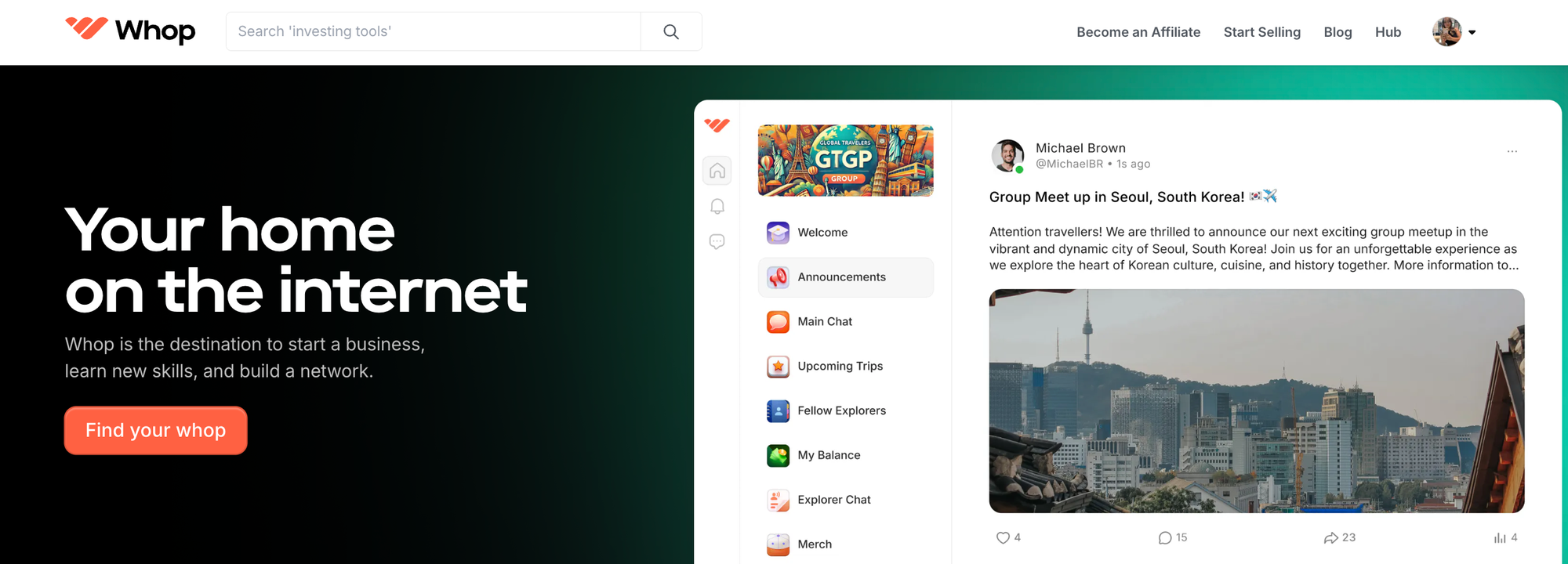
If you’re starting out as an online seller, you need a platform that makes your life easier. Whop is exactly what you’re looking for because it’s extremely user-friendly, allowing you to create your own whop hub where you can sell almost anything digital.
With Whop you can sell practically any type of digital product like online courses, SaaS, private community access, ebooks, and much more. Whop’s model supports both subscriptions and one-time payments, giving you total flexibility to match your pricing to your unique products. You can create your whop, add the products that you want to it, and charge for access to part or all of it.
There are no monthly charges and the transaction fee is only 3%. If you want to join the Whop marketplace then these fees increase to 30%, but you benefit from having your products in front of over four million customers per month. For high-volume sellers, enterprise pricing is available.
2. Etsy
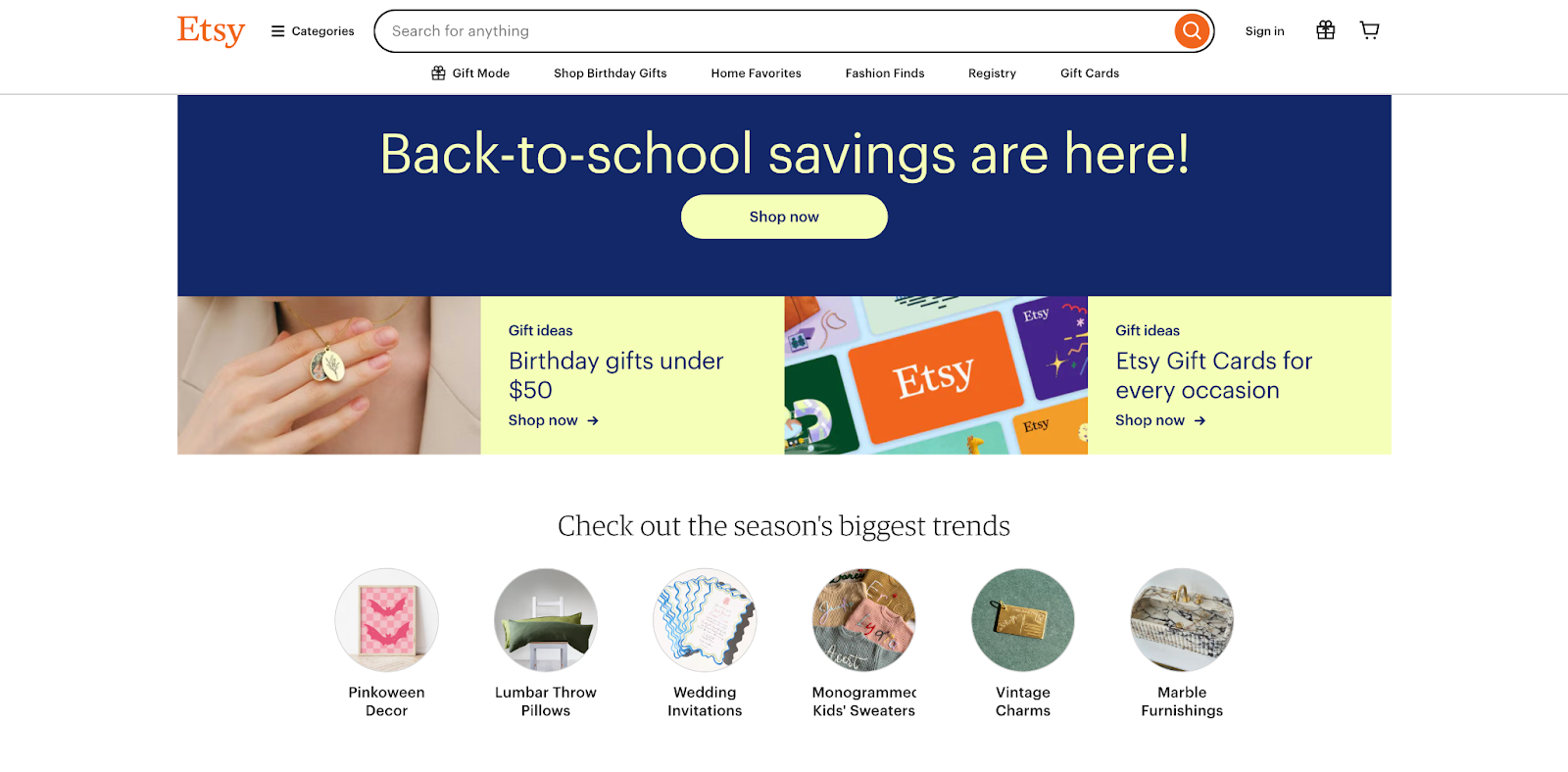
Etsy is a popular online marketplace traditionally known for handmade and vintage items. However, it has also become a platform for selling digital products such as printables, design files, digital art, and more.
With over 100 million active buyers, Etsy offers a ready-made audience for your digital products. This massive user base means your products have a higher chance of being discovered with the help of a strong SEO-friendly platform.
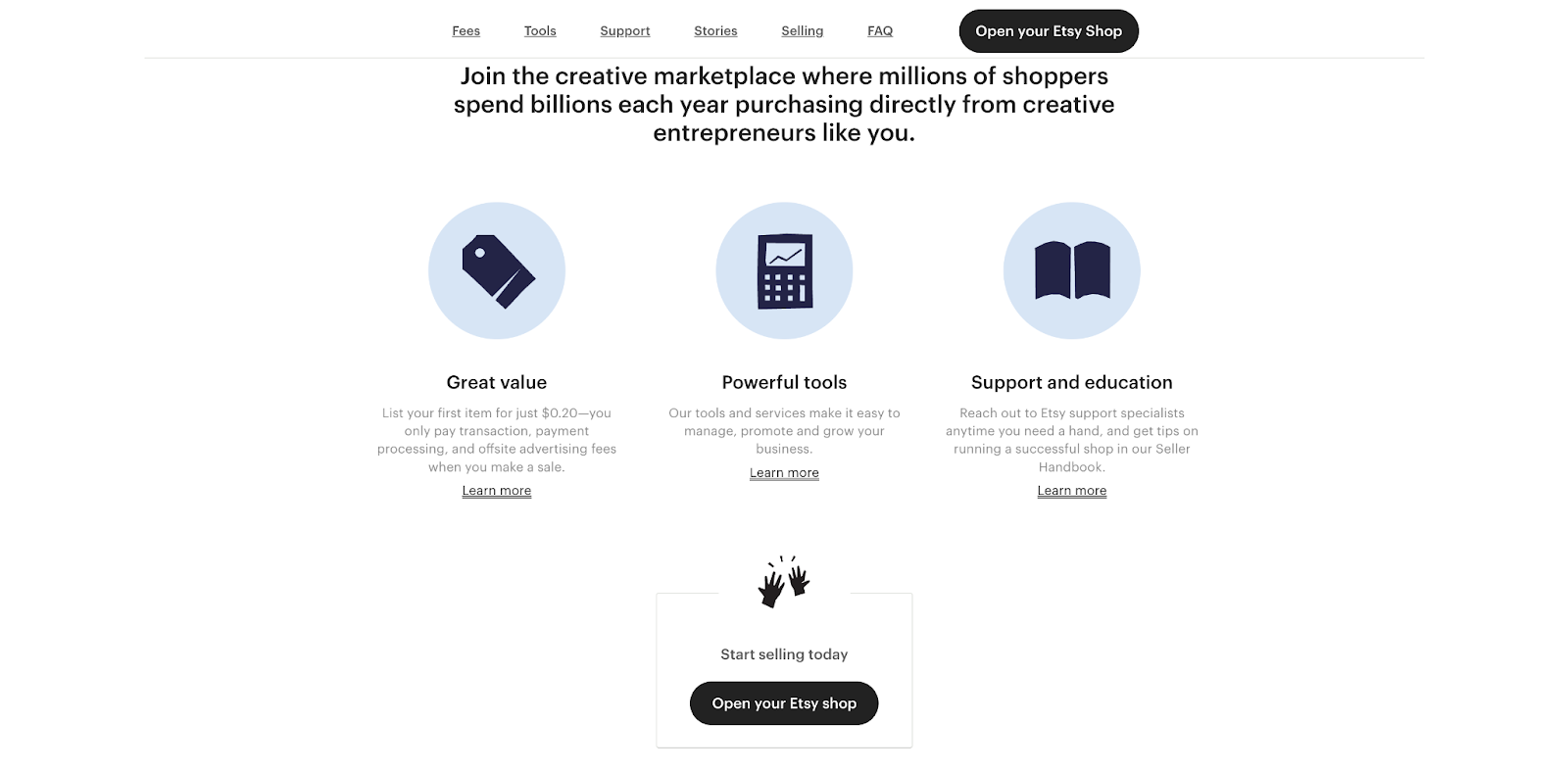
The popularity of Etsy also means that the market is highly competitive. Without proper optimization of your listings, it could be hard to stand out among many other sellers.
It’s also important to notice that Etsy charges listing fees, transaction fees, and payment processing fees. Keep that in mind when you’re setting your prices. Even more important - when selling digital products on Etsy, you can only have five files up for sale at one time, so if you have more than five digital products you are limited by Etsy's restrictions. Plus, you cannot create or sell a community on Etsy.
3. Shopify

Offering robust tools for selling both physical and digital products, Shopify is one of the most popular ecommerce platforms. One big differential this platform has is allowing the creation of a fully customizable online store with various apps and integrations to enhance functionality.
It’s suitable for both small businesses and large companies, making it a versatile choice with an integrated payment system.
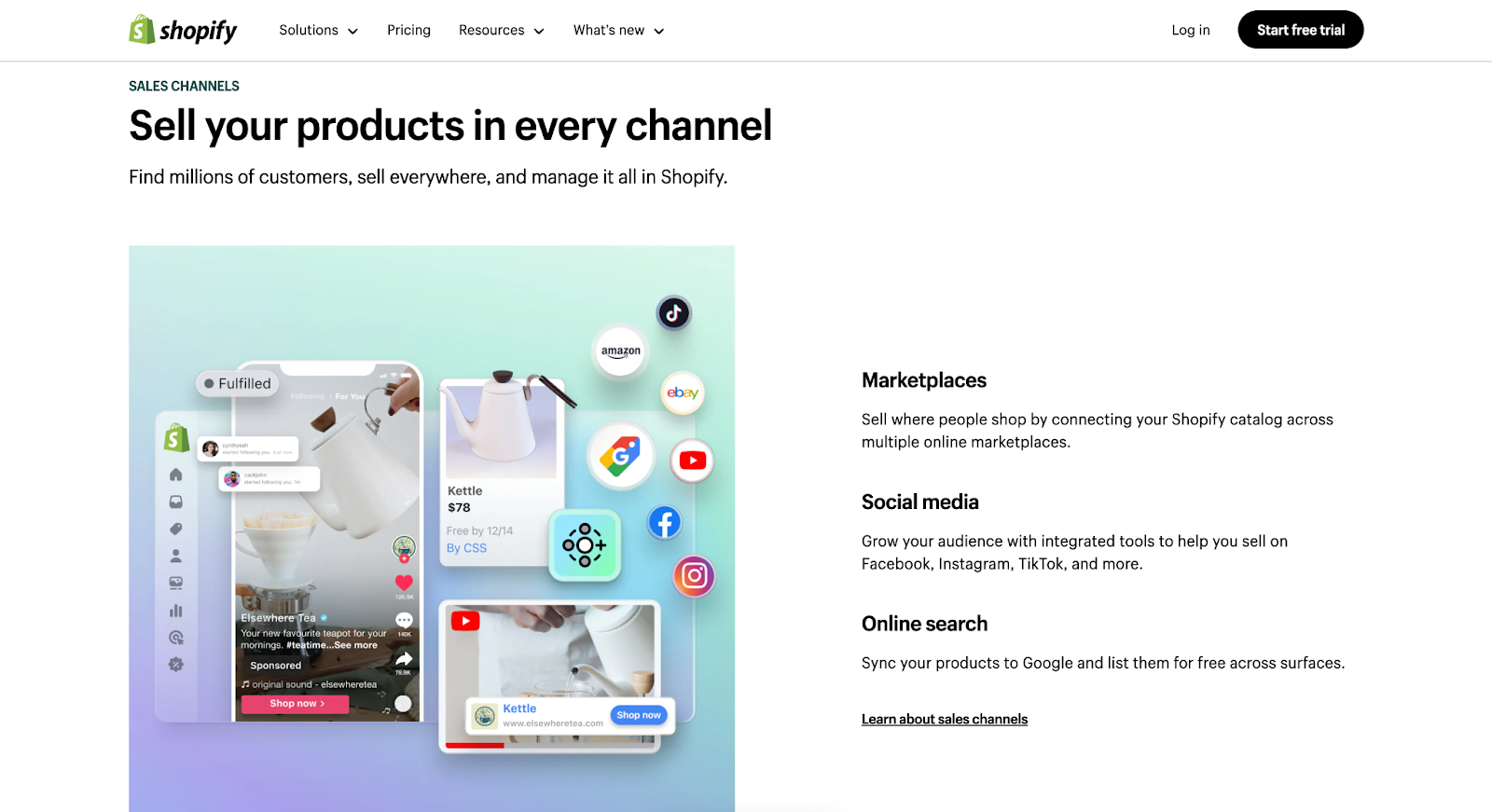
With all these features, Shopify may not be exactly user-friendly for beginners. It has a learning curve, but it's very rewarding for sellers who want full control over their online store and are willing to invest time and money into a customizable, scalable platform.
It’s important to understand that Shopify is simply a website builder, you’re still in charge of driving traffic to the site. Plus, while you can sell digital products on Shopify, it was not created for this purpose, and so lacks important features such as a course builder.
4. Teachable
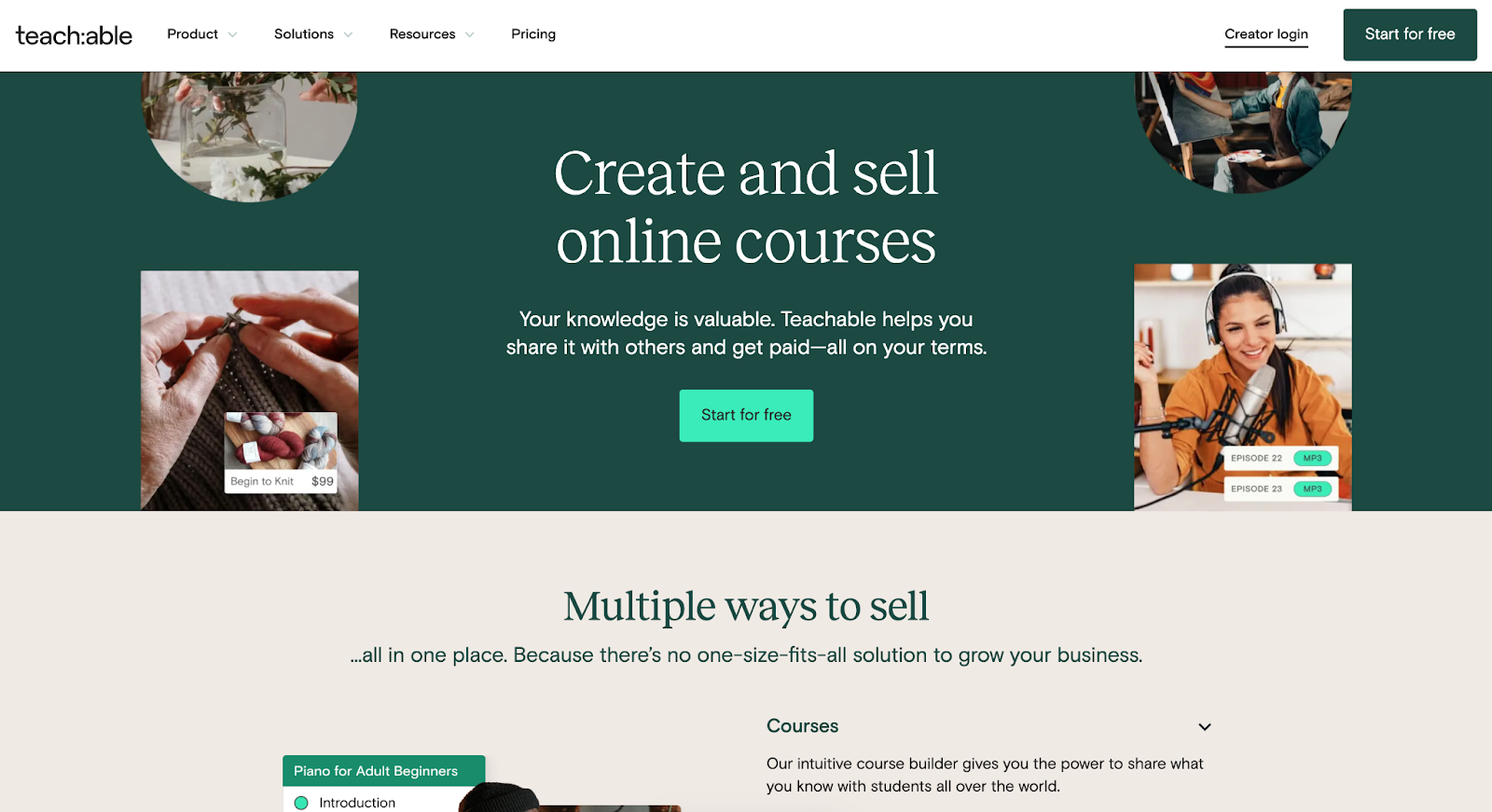
If you are an expert looking to produce and market online courses, the best place to sell this digital product is on a platform focused on this specific niche.
Teachable is a specialized site for creating and selling online courses. It provides all the tools you need to build, market, and sell online courses, being the go-to platform for creators looking to grow their earnings and their impact. It comes complete with video hosting, quizzes, and certificates.
It’s really created for the educational niche, offering tools designed for teachers and professionals who want to sell their online products without needing to worry about technical aspects like video hosting. However, there are also downsides to selling digital products with Teachable. For example, Teachable calls itself the 'anti-all-in-one platform', meaning that you have to rely on multiple integrations for a fully-fledged business, and the cost of this can quickly add up.
5. Sellfy
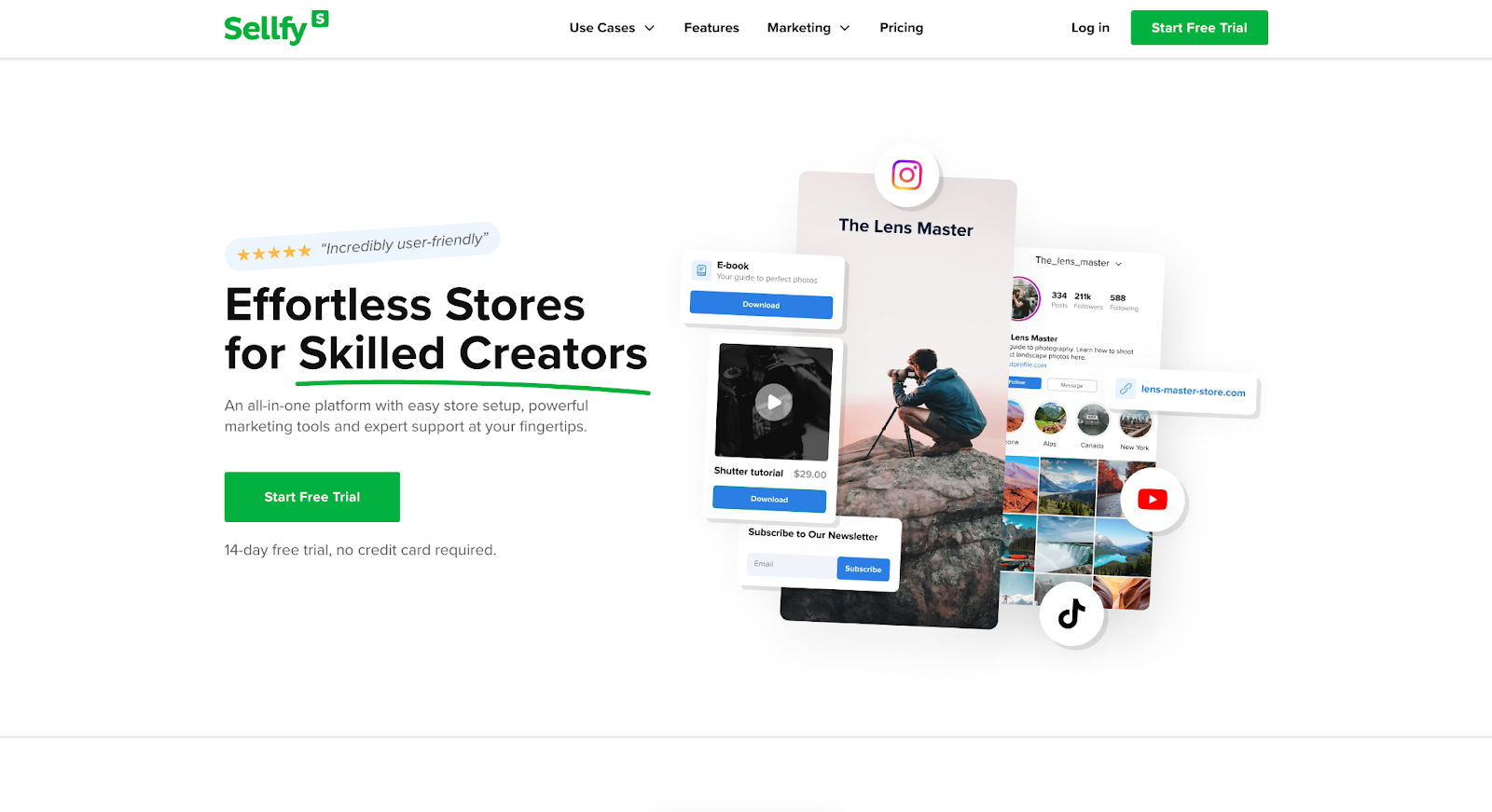
Sellfy is an easy-to-use ecommerce platform tailored for creators who want to sell digital products, physical products, or community subscriptions. It has a simple setup designed to cater to digital creators.
The platform also includes tools for email marketing, discount codes, and upselling, being pretty much an all-in-one platform with full support for digital and physical products.
But perhaps one of Sellfy's biggest attractions for creators who want to sell digital products is the absence of transaction fees. Sellfy doesn’t charge any extra fees, making it more cost-effective for sellers compared to other platforms.
But that doesn't mean Sellfy is totally free to use, of course. There are monthly fees you need to pay, and you can choose between starter, business, or premium plans, which range in pricing. It is also important to note that Sellfy has a yearly cap of $200k in revenue - and that is on the highest plan. If you are a high-level seller striving for success, then Sellfy can hinder your growth. In comparison, there are sellers on Whop who have made over $250k in just one month!
6. Creative Market
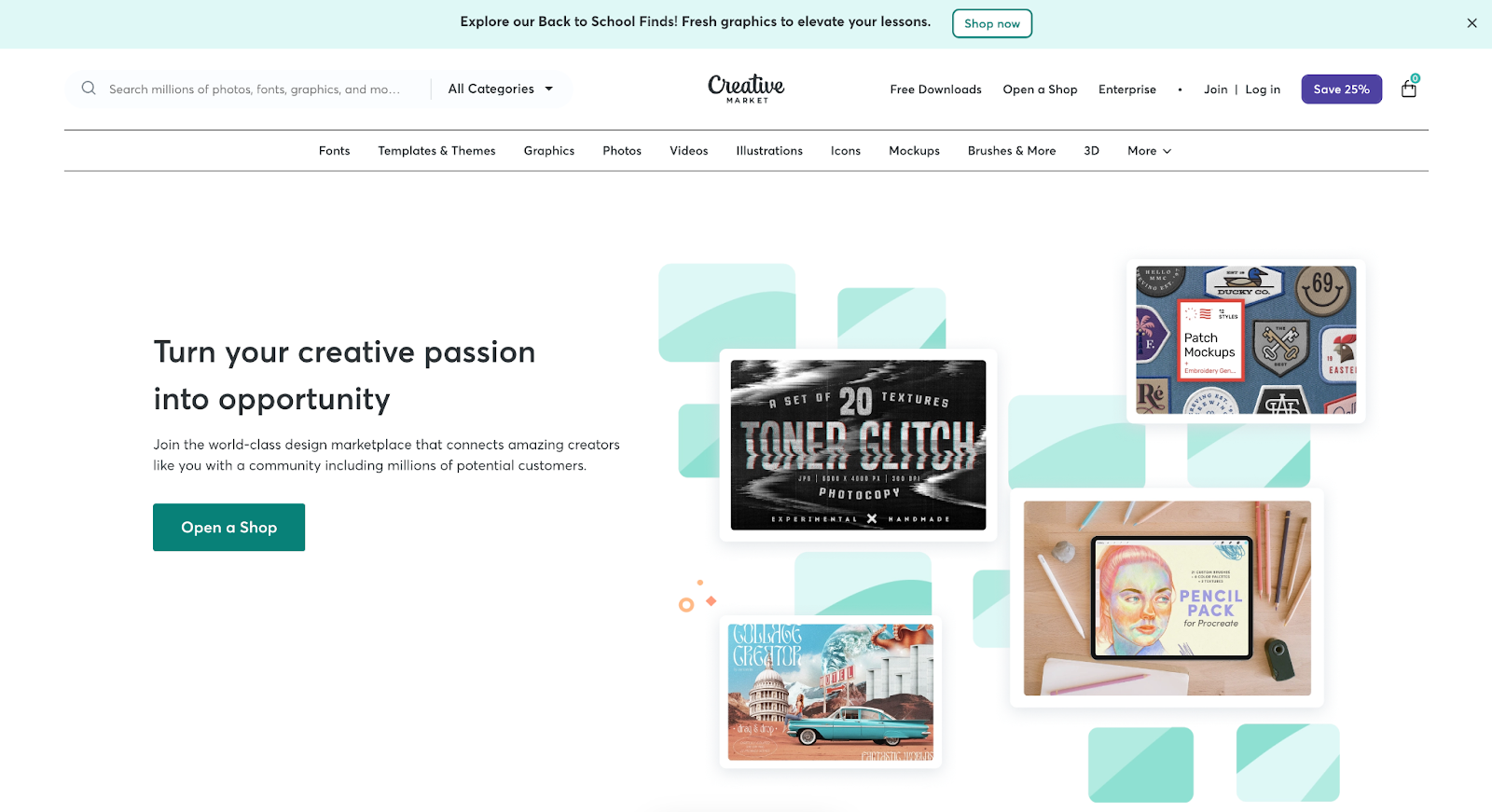
Creative Market is an online marketplace that focuses on digital design assets, including templates, graphics, fonts, and digital themes. It’s an amazing platform for designers and creators looking to sell their digital products to a dedicated audience.
This platform supports a community of designers, offering exposure through curated and featured products. It also covers the credit card processing fees and marketing expenses that help you make more money, but one thing to note is that you will keep only 50% of each sale.
This 50% split between the platform and the seller can be a bit drastic, but since you don’t need to worry about finding customers it can relieve some of the burden. Still, when you look at the pricing across creative market is seems relatively low, with font packages selling for between $2 and $75 dollars, meaning sellers only keep $1-$32.5 dollars per sale. It’s important to be aware of this when considering Creative Market as a marketplace for selling digital products.
7. Gumroad
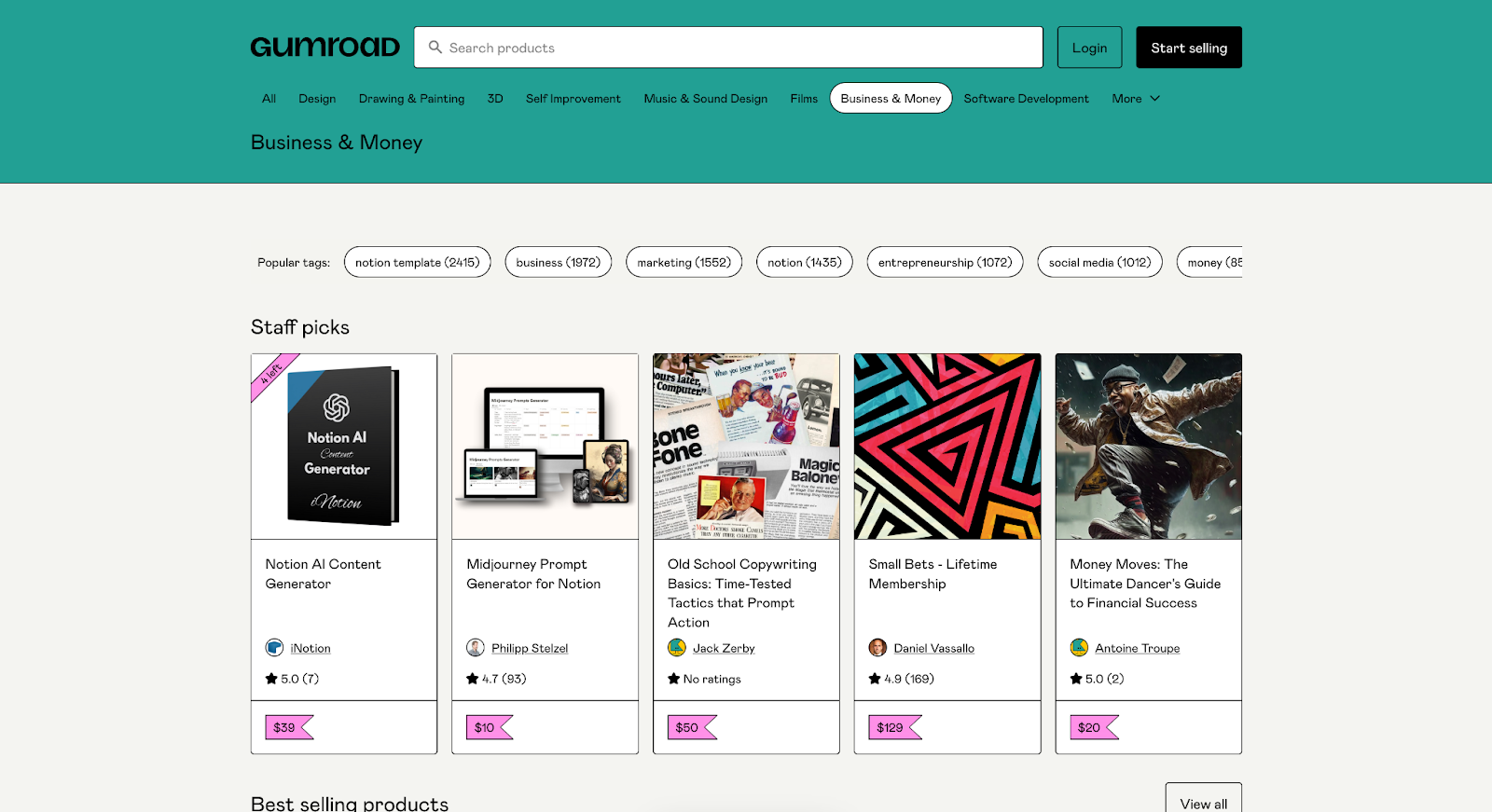
Known for its simplicity and ease of use, Gumroad is an ecommerce platform designed specifically for creators who want to sell digital products such as ebooks, music, software, online courses, and more. As straightforward as it is user-friendly, Gumroad’s interface is intuitive, making it easy to set up and start selling quickly.
A big advantage of Gumroad is the fact the platform doesn't charge monthly fees, taking a 10% cut of each sale. But this is also a disadvantage, as you may consider this percentage a bit high compared to other platforms. Plus, this does not get you onto the Gumroad Discover marketplace. If you do want to join the marketplace, you will pay an 'increased promotional fee' which is not outlined, and if anyone purchases your products through Gumroad's mobile app, you pay a 40% fee - ouch.
8. Udemy

Considered one of the leading platforms for creating and selling online courses, Udemy has global recognition and reach. It’s recognized for a wide variety of courses, as well as easy-to-use creation tools for sellers who want to monetize their skills by creating digital products.
Udemy features over 210,000 video courses made available to 62 million students and over 15,000 enterprise customers. It offers tools for creating video-based courses, including the creation of assignments and certificates for students.
What is confusing is that Udemy technically doesn't charge fees, but the revenue split between you and the platform depends directly on whether your digital product is sold through your own promotion efforts or not.
Meaning, if you attract buyers to your course through your own coupons or referral links, then you keep 97% of the revenue from the sale. However, if students buy your course through browsing the marketplace, or simply buy it without using your referral or coupons, then you only keep 37% of the course sales. That's only if you're a Premium Instructor who is able to set a price for your own course.
Udemy Business works a little differently. Udemy sets aside 25% of monthly subscription revenue from Udemy Business customers. This 25% is shared out across all instructors who produce this course content. So, you only get a portion of a portion, based on the amount of your course content that was consumed.
It's a business model that requires a strong sense of self-marketing. You can make a profit selling online courses on Udemy, but you need to market yourself extremely well.
Whop: The Best Place to Sell Digital Products
With all these options, one thing is clear: Whop is the best place to sell digital products.
It has no platform subscription fees and is extra versatile when it comes to the products you’re able to sell. Rather than focusing on one digital product like communities or courses, Whop has created a platform where you can create and sell all kinds of digital products.
With Whop, you create your own whop hub. Your whop is the home of your business, and you have the flexibility to add or remove apps (features) in your whop as you like to suit your business needs. For example, if you are a sports capper wanting to sell sports picks, you can add the Chat App for community conversation, the Forum App for Q and A, and the Sports App to sell sports betting picks.
On the other hand, if you're a fashion influencer, you can create your whop with the Chat App for your community, the Video Calls app for one-on-one fashion consultations, the Affiliate Links app to earn passive income by promoting the clothes you buy, and the Files app to sell styling 101 downloadable guides.
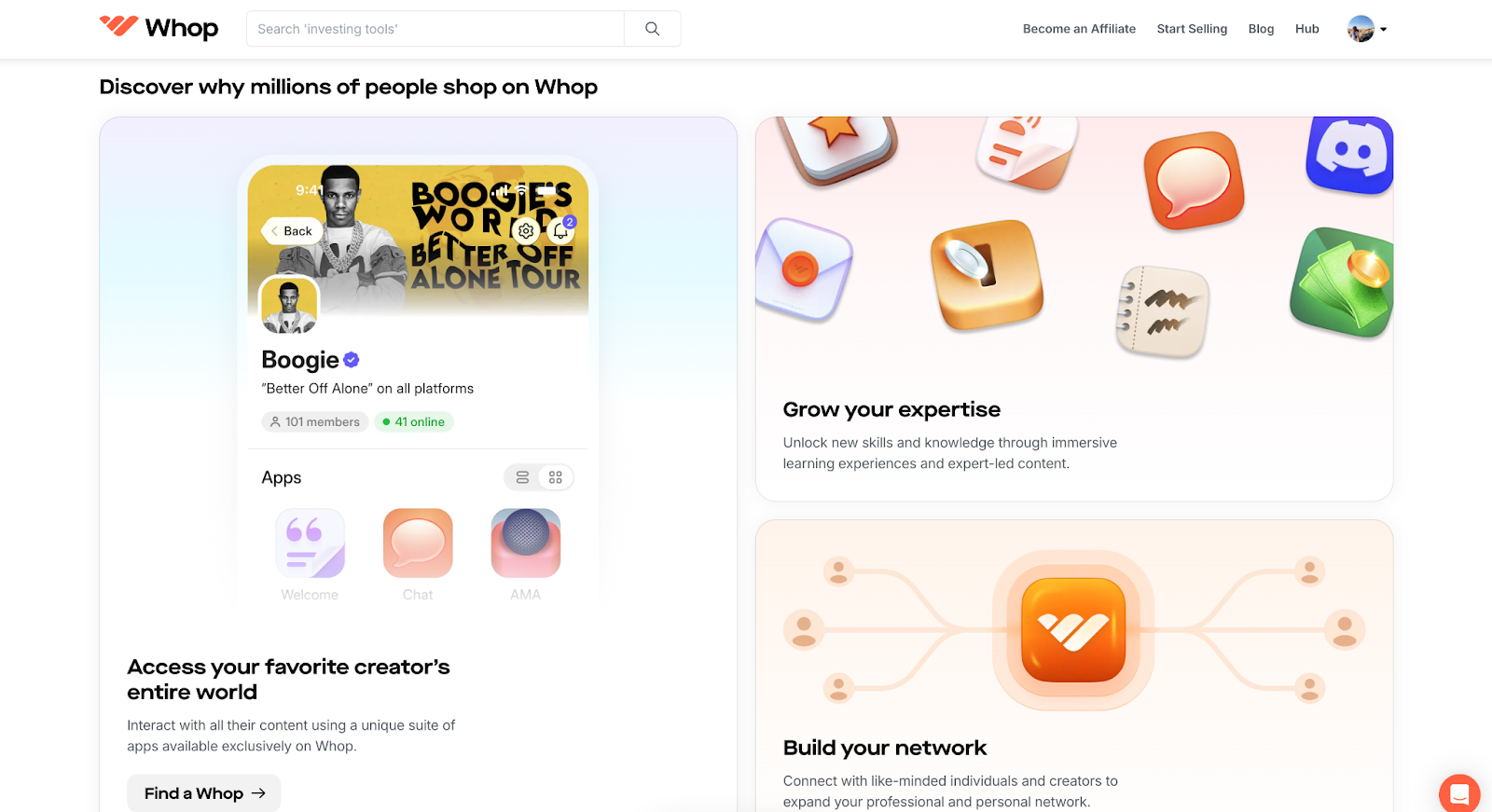
No matter how you choose to set up your whop, you can sell access to all or part of it. Set once-off-payments for products like ebooks and courses, and membership subscription fees for the likes of community access and giveaways. Multiple products, multiple payment options - one whop.
And if you're concerned about the time spent on customer service and billing, Whop has you covered on that too. With a 24/7 live support team ready to assist, you can keep your customers satisfied without getting tired and spreading yourself too thin.
Boasting some of the best rates in the industry, taking just 3% from each sale that you bring in, Whop’s success is directly tied to yours—we only profit when you do. We eliminate the frustration of complex subscription tiers, in a simple, transparent solution designed to support your success at all times, not hinder it.
Getting started is quick and easy. Sign up with Whop today and start selling your digital products in just minutes.
Digital Products FAQs
Some of the most frequently asked questions about digital products.
Why Is Selling Digital Products a Good Business?
Selling digital products can be a very profitable business model because it has low overhead costs and doesn’t require physical manufacturing, shipping, or even inventory management, making it easier to sell your products globally.
Also, digital products are an excellent source of passive income because once you’ve created a digital product, it can be sold repeatedly and indefinitely without needing to be recreated.
How Do I Create Digital Products?
First, you must identify your audience and know what niche you want to sell to, based on the areas in which you have the most knowledge and skills.
After that, use editing tools to create your product, such as Adobe, CorelDRAW, or Canva. It will depend on your own skills, as it’s even possible to scan physical art to sell as digital products.
How Do I Find a Low-Competition Niche To Start Selling Digital Products?
To discover a low-competition ecommerce niche, start by identifying a popular product category then narrow your focus to a more specific sub-niche within that category. This approach ensures there’s existing demand for your digital product while giving you the opportunity to stand out in a less crowded market.
Why You Should Trust Us
Joe Niehaus is an ecommerce content writer at Whop as well as a product reviewer for publications like The Quality Edit, Travel + Leisure, Men’s Health, and others. He dedicates much of his time to researching trending products on social media, giving him keen insight into what customers are shopping for right now.





